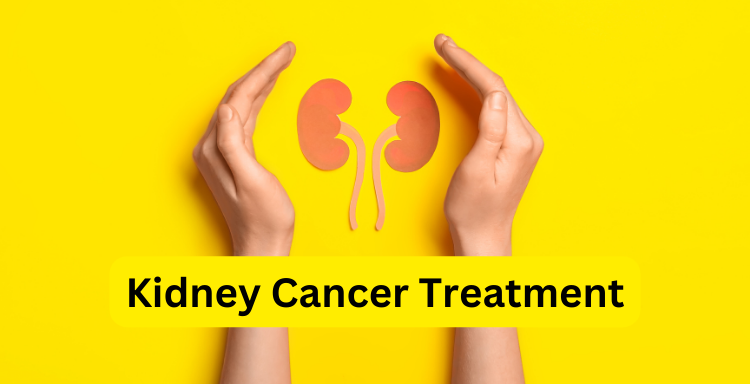Dr Anup Ramani @ Copyright 2024
By Dr. Anup Ramani
Kidney cancer is one of the most challenging malignancies due to its silent progression, late-stage diagnosis and resistance to chemotherapy. While early detection is key, surgical intervention remains the most effective treatment, with robotic-assisted procedures offering superior precision and faster recovery.
In this article, we will explore the complexities of kidney cancer treatment, the role of robotic surgery, key factors influencing surgical decisions and the growing demand for robotic treatment in India and globally.
Understanding the Complexities of Kidney Cancer Treatment
Kidney cancer treatment is complex due to several factors, including tumor size, location, stage and patient health conditions. The major challenges include:
1. Late Diagnosis and Silent Progression
- Most kidney tumors are asymptomatic in early stages, leading to late-stage detection.
- Only 25-30% of kidney cancers are diagnosed at an early stage when surgical removal is most effective.
- By the time symptoms like blood in urine, lower back pain and weight loss appear, the cancer may have already spread.
2. Complex Surgical Considerations
Surgery remains the gold standard for kidney cancer treatment, but deciding the right surgical approach is crucial. The choice depends on:
- Tumor Size & Location– Small tumors (<4 cm) may allow for partial nephrectomy, whereas larger tumors require radical nephrectomy.
- Patient’s Kidney Function– If one kidney is already impaired, nephron-sparing surgery is preferred.
- Cancer Stage– If cancer has spread beyond the kidney, surgery alone may not be effective, requiring additional targeted therapy.
3. Risks and Challenges in Surgery
Kidney cancer surgeries, especially traditional open surgeries, come with significant challenges, such as:
- Excessive blood loss due to the kidney’s high vascularity.
- Longer recovery times, especially for radical nephrectomy.
- Potential damage to surrounding organs, like the adrenal gland or vena cava, in complex cases.
4. Limited Effectiveness of Non-Surgical Treatments
Unlike other cancers, kidney cancer does not respond well to chemotherapy or radiation therapy.
- Targeted therapies and immunotherapy have shown promise but are usually considered for advanced or metastatic cases.
- Surgery remains the most effective treatment option for localized kidney cancer.
Factors Considered Before Kidney Cancer Surgery
Before performing surgery, specialists evaluate multiple factors to determine the best treatment approach:
1. Tumor Characteristics
- Size– Tumors smaller than 4 cm are usually treated with partial nephrectomy, whereas larger tumors require total nephrectomy.
- Location– Tumors near critical structures require robotic precision to minimize damage.
2. Type of Surgery Required
- Robotic Partial Nephrectomy– Removes only the tumor, preserving kidney function.
- Robotic Radical Nephrectomy– Removes the entire kidney if the tumor is too large or invasive.
3. Patient’s Overall Health
- Patients with chronic kidney disease, hypertension or diabetes may need nephron-sparing approaches to avoid long-term dialysis.
- The patient’s age, heart condition and immune response are also considered before recommending surgery.
4. Risk of Cancer Spreading
- If cancer has spread to lymph nodes or distant organs, surgery may be combined with targeted therapy.
- In metastatic cases, the goal is to debulk the tumor and reduce symptoms rather than achieve a complete cure.

Importance of Kidney Cancer Surgery
Surgical removal of the tumor is the most effective way to cure kidney cancer when diagnosed at an early stage.
1. High Survival Rates
- For localized kidney cancer, surgery leads to a 5-year survival rate of 93%.
- For larger tumors without metastasis, survival rates drop to 70-80%.
- In cases where cancer spreads beyond the kidney, survival rates decrease to 12%.
2. Preventing Further Spread
- Surgery removes the primary tumor, reducing the risk of spreading to the lungs, bones and liver.
- Delaying surgery increases the likelihood of metastasis, making treatment less effective.
3. Better Quality of Life
- Successful kidney cancer surgery allows patients to return to a normal lifestyle.
- Compared to chemotherapy or radiation, surgery offers fewer side effects and a faster recovery.
The Role of Robotic Surgery in Kidney Cancer Treatment
Robotic-assisted surgery is revolutionizing kidney cancer treatment, offering better precision, faster recovery and fewer complications.
Key Advantages of Robotic Surgery for Kidney Cancer in India and Worldwide
- Minimal Blood Loss-The Da Vinci robotic system allows micro-level precision, reducing blood loss by 50-70%.
- Smaller Incisions– Instead of a large open cut, robotic surgery uses small keyhole incisions.
- Faster Recovery– Patients return to work in 2-3 weeks, compared to 6-8 weeks in open surgery.
- Better Kidney Preservation– Partial nephrectomy using robotic techniques preserves more healthy kidney tissue.

- Lower Risk of Infection & Complications- Reduced hospital stay and fewer post-surgical infections.
- Innovative Approaches:
Surgeons in Mumbai are adept at using the latest technologies for procedures like robotic surgery for kidney cancer, ensuring optimal outcomes.
Statistics on Robotic Kidney Cancer Surgery in India and Globally
1. India’s Growing Demand for Robotic Kidney Cancer Surgery
- In 2023, over 10,000 robotic kidney surgeries were performed in India, a 35% increase from 2020.
- Mumbai, Delhi and Chennai have emerged as key centers for Minimal Invasive Surgery for Kidney Cancer in India.
- Robotic Radical Nephrectomy in India has a success rate of over 90% for localized kidney cancer.
2. Global Trends in Robotic Kidney Surgery
- United States -Over 75% of kidney cancer surgeries are now performed robotically.
- Europe and Other Countries like Germany, France and the UK have adopted robotic kidney surgery as a standard practice.
3. Future Scope of Robotic Kidney Cancer Surgery
- AI and Machine Learning Integration– Future robotic systems will use AI-driven decision-making for better tumor removal.
- Tele-Robotic Surgery– Remote surgeries performed by specialists across the world.
Conclusion
Kidney cancer is a complex disease, but early diagnosis and advanced surgical techniques have significantly improved survival rates. Robotic and minimal invasive surgeries in India have emerged as the preferred approach, offering high precision, reduced complications and faster recovery.
With Mumbai and other metropolitan cities leading the way in robotic nephrectomy, India is fast becoming a global hub for kidney cancer surgery. The future of robotic kidney cancer treatment is promising, with AI integration, enhanced precision and accessibility improvements making it the preferred treatment worldwide.
FAQs About Kidney Cancer Complexities
1. What is the best treatment for kidney cancer?
The best treatment depends on the stage of cancer. Robotic Surgery for Kidney Cancer, including Robotic Radical Nephrectomy or Robotic Partial Nephrectomy, offers high precision and faster recovery.
2. Can kidney cancer be treated without surgery?
In early cases, targeted therapy or immunotherapy may help. However, surgery remains the most effective treatment for removing tumors.
3. Is robotic kidney cancer surgery better than traditional surgery?
Yes. Robotic Kidney Cancer Surgery offers:
- Smaller incisions
- Less pain and bleeding
- Faster recovery
Read More Articles on Robotic Kidney Cancer Surgery
About Author

Uro-Oncological & Robotic Surgeon
Dr. Anup Ramani is a robotic uro-oncological surgeon and an internationally recognized expert in robotic surgery for prostate, kidney and urinary bladder cancers. With more than two decades of robotic experience and 2,000+ robotic procedures, he brings unmatched precision and outcomes to complex uro-oncology cases. He is widely published in his field and is known for a personal, transparent approach-often spending over an hour in initial consultations to educate patients on its disease, surgery and recovery. His expertise spans prostate cancer treatment, kidney and bladder cancer surgery, adrenal gland surgery, kidney stone treatment, penile cancer surgery and enlarged prostate management. Dr. Ramani advocates the advantages of robotic surgery-magnified 3D vision, tremor-filtered precision, minimal scarring, lower blood loss and faster recovery-helping patients return to life sooner.
Table of Contents
Recent Blogs
Best Uro-Oncological surgeon
Specialist in India for Robotic Surgery
MCh, DNB, MS, DNB
Dr. Anup Ramani
CONTACT
Uro-Oncologist in India,
Best Robotic Surgeon for Uro Oncology Surgery
1407, One Lodha Place Next to World Towers Senapati Bapat Marg, Worli, Mumbai. 400013.
Dr Anup Ramani @ Copyright 2024 – Website Maintenance, SEO & GEO by Opal Infotech
- Partial penectomy is done in cases where glans and distal penis is involved with carcinoma.
- Partial penectomy is a type of organ-preserving surgery. Preservation of sexual and micturational function depends on the surgical dissection and reconstruction of residual urethra.
- Patients who develop stones in the kidney or ureter, often experience severe pain.
- This condition usually needs a procedure to remove the kidney stones.
- This procedure is called ureteroscopy and is performed very commonly.
- It does not require any cuts and hence it is painless.
- The procedure is performed with an endoscope inserted through the penis under spinal anesthesia.
- The scope is inserted through the penis into the kidney and stones are dissolved with a laser.
- The procedure takes about 40-50 minutes.
- A catheter (urine pipe) is kept after the procedure to drain the bladder. A stent is kept in the kidney at the same time.
- Patient is mobile and walking in the room the same evening.
- Hospital stay is one night and patient is discharged the next day after removal of the catheter.
- Patient has to come back after six weeks to remove the stent in the kidney.
- Patients can resume office a week after surgery and heavy activities like running, weight lifting, a month after the procedure.
- We offer fixed packages for this procedure which can be obtained by calling our helpline +91 9967666060.
- Men with an enlarged prostate, which is a normal ageing changes, often experiencing difficulty passing urine. This condition usually needs a procedure to trim the prostate and relieve the blockage.
- This procedure is called TURP and is performed very commonly.
- It does not require any cuts and hence it is painless.
- The procedure is performed with an endoscope inserted through the penis under spinal anaesthesia.
- The overgrown prostate is dissolved with a laser bloodlessly.
- The procedure takes about 40 minutes.
- A catheter (urine pipe) is kept after the procedure to drain the bladder.
- Patient is mobile and walking in the room the same evening.
- Hospital stay is two nights and patient is discharged with the catheter, which is removed after 4 days.
- Patients can resume office a week after surgery and heavy activities like running, weight lifting, a month after the procedure.
- We offer fixed packages for this procedure which can be obtained by calling our helpline +91 9967666060.
-
Robotic adrenalectomy is a sophisticated, complex surgery and it is very important that an experienced surgeon performs this surgery to avoid major complications.
-
Once the anesthesia is done, and patient positioned, three micro cuts (3mm each) are made in the patient’s abdomen.
-
The arms of the Da Vinci robot are connected to the cuts via ports (tubes).
-
Dr. Ramani then sits in the controlling console to perform the surgery.
-
On an average, a robotic adrenalectomy takes one hour.
-
The surgery is almost completely bloodless and there has never been any need to transfuse blood after surgery.
-
A urine catheter and bag to drain the bladder is inserted during surgery.
-
A tiny drain pipe may be inserted in the surgical side of the abdomen, connected to a bag.
-
Patient is kept nil-by-mouth the day of the surgery, with IV fluids. Sips of water are started the next day and solid food by day three.
-
The drain pipe, if kept, is removed in the room on day 2 after surgery.
-
The catheter is removed on day two after surgery.
-
Total hospital stay for robotic adrenalectomy is 4 nights (including night before surgery).
-
Post discharge, a doctor from the surgical team visits the patient at home/ hotel room once every day.
On the day of discharge, patient is totally self-sufficient. They are able to walk freely without any pain, dress themselves, shower, toilet and they do not need to hire any nurse or help at home. Almost all patients are back to work within 2 weeks of surgery.
Heavy activities like running, weight lifting can be resumed after a month
Follow up after an adrenalectomy is in the form of CT scans, once a year for 5 years.
Local patients usually meet Dr. Ramani after two weeks to discuss report.Outstation patients are counselled on a phone consultation.
- Dr. Ramani is one of the very few surgeons in India who has the expertise to perform a robotic surgery for bladder cancer, which includes removing the urinary bladder and reconstructing a new bladder robotically.
- Robotic radical cystectomy is an extremely sophisticated, complex surgery and it is very important that an experienced surgeon performs this surgery to avoid major complications.
- Once the anaesthesia is done, and patient positioned, six micro cuts (3mm each) are made in the patient’s abdomen.
- The arms of the Da Vinci robot are connected to the cuts via ports (tubes).
- Dr. Ramani then sits in the controlling console to perform the surgery.
- On an average, a robotic radical cystectomy with an ileal conduit takes 3-4 hours.
- The surgery is almost completely bloodless and there has never been any need to transfuse blood after surgery.
- A urine catheter and bag to drain the new bladder is inserted during surgery.
- Two tiny drain pipe in inserted in the surgical side of the abdomen, connected to a bag.
- Patient is kept nil-by-mouth for 4 days after surgery with IV supplementation of patient’s daily requirements of calories, fats, carbohydrates, proteins and electrolytes.
- The drain pipes are removed in the room on day 3-5 after surgery.
- Total hospital stay for radical cystectomy is 8 nights (including night before surgery).
- Post discharge, a doctor from the surgical team visits the patient at home/ hotel room once every day.
- On the day of discharge, patient is totally self-sufficient. They are able to walk freely without any pain, dress themselves, shower, toilet and they do not need to hire any nurse or help at home.
- Almost all patients are back to work within 6 weeks of surgery. Heavy activities like running, weight lifting can be resumed after two months.
Follow up after a radical a cystectomy is in the form of CT scans, once a year for 5 years.
Histopathology report: Local patients usually meet Dr. Ramani after two weeks to discuss report.
Outstation patients are counselled on a phone consult. Depending on the report, patient may or may not need chemotherapy after surgery.
If chemo is needed, patients may choose to get it done with a medical oncologist of their choice or avail the services of one of the four medical oncologists on our team.
- Robotic partial nephrectomy is a sophisticated, complex surgery and it is very important that an experienced surgeon performs this surgery to avoid major complications. Robotic radical (total) nephrectomy is
- relatively easier but still requires significant experience to consistently deliver results.
- Once the anaesthesia is done, and patient positioned, five micro cuts (3mm each) are made in the patient’s abdomen.
- The arms of the Da Vinci robot are connected to the cuts via ports (tubes).
- Dr. Ramani then sits in the controlling console to perform the surgery.
- On an average, a robotic radical nephrectomy takes one hour and a robotic partial nephrectomy takes about an hour and half.
- The surgery is almost completely bloodless and there has never been any need to transfuse blood after surgery.
- A urine catheter and bag to drain the bladder is inserted during surgery.
- A tiny drain pipe in inserted in the surgical side of the abdomen, connected to a bag.
- Patient is kept nil-by-mouth the day of the surgery, with IV fluids. Sips of water are started the next day and solid food by day three.
- The drain pipe is removed in the room on day 3 after surgery. The catheter is removed on day two after surgery.
- Total hospital stay for radical/partial nephrectomy is 4 nights (including night before surgery).
- Post discharge, a doctor from the surgical team visits the patient at home/ hotel room once every day.
- On the day of discharge, patient is totally self- sufficient.
- They are able to walk freely without any pain, dress themselves, shower, toilet and they do not need to hire any nurse or help at home.
- Almost all patients are back to work within 2-3 weeks of surgery.
- Heavy activities like running, weight lifting can be resumed after a month.
- Follow up after a radical/partial Nephrectomy is in the form of CT scans, once a year for 5 years.
- Local patients usually meet Dr. Ramani after two weeks to discuss report.
- Outstation patients are counselled on a phone consultation.







